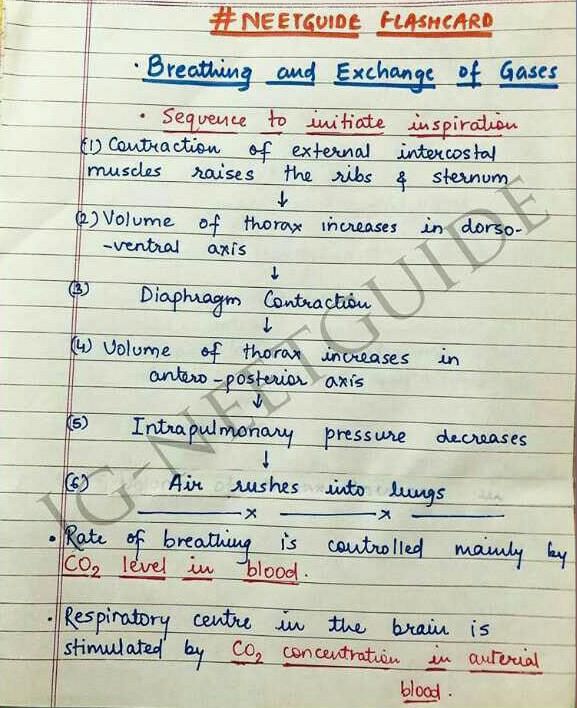NEET Exam > NEET Questions > Quick notes on Breathing & exchange of gases ...
Start Learning for Free
Quick notes on Breathing & exchange of gases [part-1]?
Most Upvoted Answer
Quick notes on Breathing & exchange of gases [part-1]?

Community Answer
Quick notes on Breathing & exchange of gases [part-1]?
- Breathing is the process of inhaling oxygen and exhaling carbon dioxide.
- It is an involuntary action controlled by the respiratory system.
- The primary purpose of breathing is to supply oxygen to the body's cells and remove waste carbon dioxide.
- Breathing involves the movement of the diaphragm and the intercostal muscles.
- The diaphragm contracts and moves downward during inhalation, allowing the lungs to expand and fill with air.
- The intercostal muscles between the ribs also assist in expanding the chest cavity during inhalation.
- Exhalation occurs when the diaphragm and intercostal muscles relax, causing the lungs to deflate and expel carbon dioxide.
- Proper breathing techniques can help improve lung capacity, reduce stress, and promote relaxation.
- Deep breathing exercises, such as diaphragmatic breathing, can increase oxygen intake and promote a sense of calmness.
- Breathing is closely linked to the body's stress response, with shallow and rapid breathing often associated with anxiety or panic.
- Various factors, such as physical activity, emotions, and environmental conditions, can affect the rate and depth of breathing.
- Certain medical conditions, such as asthma or chronic obstructive pulmonary disease (COPD), can impact breathing and require medical intervention.
- It is an involuntary action controlled by the respiratory system.
- The primary purpose of breathing is to supply oxygen to the body's cells and remove waste carbon dioxide.
- Breathing involves the movement of the diaphragm and the intercostal muscles.
- The diaphragm contracts and moves downward during inhalation, allowing the lungs to expand and fill with air.
- The intercostal muscles between the ribs also assist in expanding the chest cavity during inhalation.
- Exhalation occurs when the diaphragm and intercostal muscles relax, causing the lungs to deflate and expel carbon dioxide.
- Proper breathing techniques can help improve lung capacity, reduce stress, and promote relaxation.
- Deep breathing exercises, such as diaphragmatic breathing, can increase oxygen intake and promote a sense of calmness.
- Breathing is closely linked to the body's stress response, with shallow and rapid breathing often associated with anxiety or panic.
- Various factors, such as physical activity, emotions, and environmental conditions, can affect the rate and depth of breathing.
- Certain medical conditions, such as asthma or chronic obstructive pulmonary disease (COPD), can impact breathing and require medical intervention.

|
Explore Courses for NEET exam
|

|
Question Description
Quick notes on Breathing & exchange of gases [part-1]? for NEET 2025 is part of NEET preparation. The Question and answers have been prepared according to the NEET exam syllabus. Information about Quick notes on Breathing & exchange of gases [part-1]? covers all topics & solutions for NEET 2025 Exam. Find important definitions, questions, meanings, examples, exercises and tests below for Quick notes on Breathing & exchange of gases [part-1]?.
Quick notes on Breathing & exchange of gases [part-1]? for NEET 2025 is part of NEET preparation. The Question and answers have been prepared according to the NEET exam syllabus. Information about Quick notes on Breathing & exchange of gases [part-1]? covers all topics & solutions for NEET 2025 Exam. Find important definitions, questions, meanings, examples, exercises and tests below for Quick notes on Breathing & exchange of gases [part-1]?.
Solutions for Quick notes on Breathing & exchange of gases [part-1]? in English & in Hindi are available as part of our courses for NEET.
Download more important topics, notes, lectures and mock test series for NEET Exam by signing up for free.
Here you can find the meaning of Quick notes on Breathing & exchange of gases [part-1]? defined & explained in the simplest way possible. Besides giving the explanation of
Quick notes on Breathing & exchange of gases [part-1]?, a detailed solution for Quick notes on Breathing & exchange of gases [part-1]? has been provided alongside types of Quick notes on Breathing & exchange of gases [part-1]? theory, EduRev gives you an
ample number of questions to practice Quick notes on Breathing & exchange of gases [part-1]? tests, examples and also practice NEET tests.

|
Explore Courses for NEET exam
|

|
Signup for Free!
Signup to see your scores go up within 7 days! Learn & Practice with 1000+ FREE Notes, Videos & Tests.


















